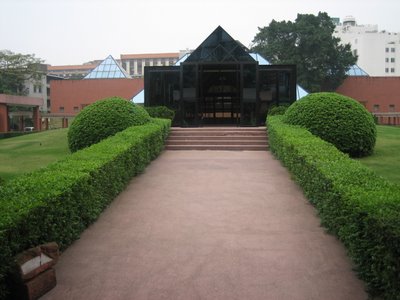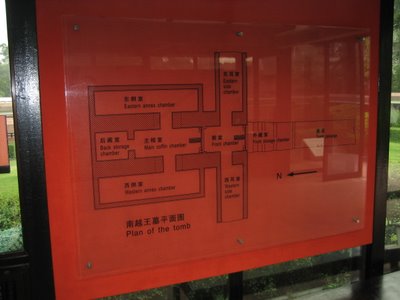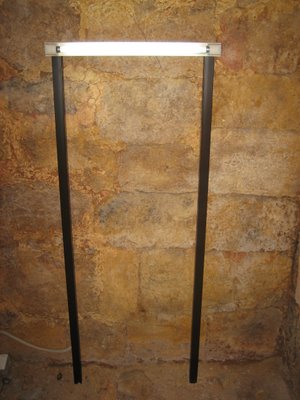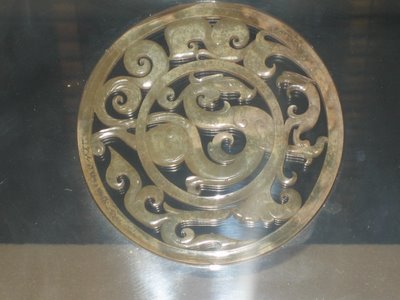
The museum is actually an elaborate structure built above and around a 2,000 year old tomb. Underneath the large pyramid in the center of the vicinity is where the remains of the Nan-Yue King were discovered, rotting away within a cold tomb. The area to the right, where there are 3 small black pyramids in where the treasures and artifacts that were found in the tomb are exhibited. The architecture of the museum on a whole is quite spectacular offering some photogenic scenery as you will soon see. I really appreciate the incorporation of pyramids into the design.

Approaching the tomb you can see how all the pyramids line up. If it was not for the tree, all three pyramids would be in clear view. It amazes me how such an awesome structure is located right in the heart of the business district and people go by it every day with no idea what lies behind those large red walls. I was forced to wonder how it came to be that the city continued to grow right around such a significant landmark. In other places I have visited a local treasure of such importance would constitute a large garden to be built around it, attracting visitors from all over the country and the rest of the world. After all, this tomb is almost 2,000 years old!

The structure of the tomb imitates that of a living chamber. It was built inside a hill that obviously no longer exists. There was long passage that led to the tomb through the side of the hill which probably collapsed at some point and knowledge of the tomb was buried and lost in history. Each of the rooms in the tomb housed sacrificial articles including one room in which the remains of 4 concubines were discovered. In all over 1000 precious relics were unearthed and the decayed remains of at least 15 people were discovered.

Within the pyramid you can get a bird’s eye view of the tomb before entering it. There are some metal beams and hinges that have been installed to maintain the structural integrity of the crypt, but overall it is holding up pretty fine. The area covers a total of about 100 square meters.

It turns out that the burial site of the Nan-Yue King was not discovered until the early 80’s!!! That is is pretty recent for something so ancient. A construction team accidentally came across is while laying foundations for a building. Some local property developer was cutting away what used to be Elephant Hill to put up apartments right in the commercial epicenter of Guangzhou at the time, and they found the resting place of one of Chinas most powerful kings. How awesome is that. And unlike many other ancient graves that have been found plundered and robbed of their artifacts, Nan-Yue’s tomb was intact with all relics and remains in place. He rested in there for 2,000 years, undisturbed until 1980, when men decided to cut down a hill to put up a building.

The tomb is now enclosed in this large glass pyramid. It seems to have loads of vents and fixtures on it and I could here a light humming and ticking sound as I explored the vicinity, so I am assuming they got a system in place to protect the ancient rocks from environmental decomposition or something.

Patrons to the museum are allowed to walk into the tomb but of course the valuable relics have been removed. The wooden floor has been reconstructed, the old one having rotted away. None of the areas are really off bounds but there are some walls protected by Plexiglas underneath which there are some murals. Other areas have lighting against the walls where you can see faint traces of murals. Crouching in the cold vaults I could feel the history around me. It is interesting to close your eyes and image that 2,000 years ago, around the time a guy called Jesus was born, Chinese laborers dug their way through solid stone on the side of a hill, building a grave for their dead king.

Within the crypt there are also sealed display cases with remains of animals, wooden trunks, pots, and even humans on display. The space is quite small so there is not really much they can exhibit there. Of the 15 humans sacrificed, most were presumably soldiers left guarding various rooms, one it has been deduced (I can’t imagine how) has been identified as a eunuch. 4 of the leftovers as I mentioned before were of the Kings concubines. Each one was laid to rest with a seal bearing her name on her chest, wearing some jewelry, and carrying a bronze mirror. I try to imagine what it was like for these women. Did they dread the day the King would die knowing that their fate would be the same? Were they dragged kicking and screaming into the vault where they were murdered or did they consume some poison tragically and romantically crossing into the afterlife to be reunited with their lover. The soldiers got a bum deal from the day they put on the uniform, as they still do. As for the eunuch, life could not have been so great anyways without a pair of balls.

After viewing the actual tomb, one can proceed to the exhibition halls where the artifacts and relics from the dig are on display. Once again the structural design of the modern museum is prominent. This picture would have been pretty cool if not for the rock with the arrow on it and the plastic ‘slippery floor’ sign. I like the way the pyramid reflects the sky from any direction and that directly behind it there is a triangular archway. These prisms also generate magnificent natural lighting within the viewing areas of the museum.

Patrons of the museum are not permitted to take pictures of the artifacts, I presume to prevent manufacturing of forgeries, or planning robberies. There were about 5 halls which contained 100’s of relics from decaying swords and ornaments to jade carvings and metal fittings from furniture that had long since rotted away. I found it spectacular that they actually had some skeletal remains of the kind on display. Some small pieces of his skull and a large chunk of his jaw with teeth in place were still intact. Equally amazing was the burial suit they had reconstructed. Where the Kings body had lain, they found a layer of flat/square jade stoned. These had apparently been strung together with silk thread creating a fill body suit for the head, arms, torso, legs, and even feet. There were also numerous metal discs with intricate carvings laid on his body and coffin. I am fascinated by the significance of circles in ancient cultures. I did sneak one picture out though, of a jade carving that I thought would make a very cool tattoo design. It was not till when I was leaving that I realized the same design was printed on my entry ticket and even on the front of the building. The image is actually of a dragon in the inner circle with his hind leg and tail extending into the outer circle. Directly across from his face you can see the face of a phoenix. His plumage flows upwards and downwards through the outer circle creating the design for the outer circle. There were a few small golden seals with very intricate dragon carvings on them that were very cool but the dragon phoenix piece was by far my favorite.

The Nan-Yue Kings Museum is a must-see for anyone visiting or living in Guangzhou. It is another one of the very few places I have found here that reveals just how rich this city is in culture and history. I have been talking about how I want to get ‘under the skin’ of this city, and yesterday I think I did, quite literally. There is definitely a lot more Guangzhou has to offer and I look forward to learning more, not just about the ancient culture but the modern culture as well.


No comments:
Post a Comment